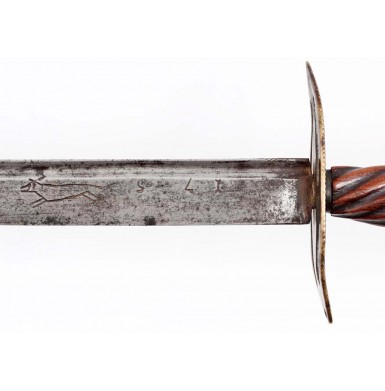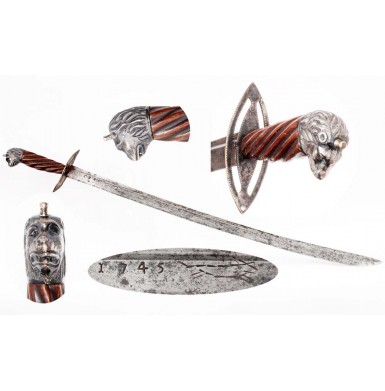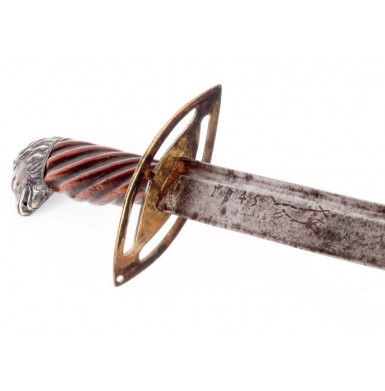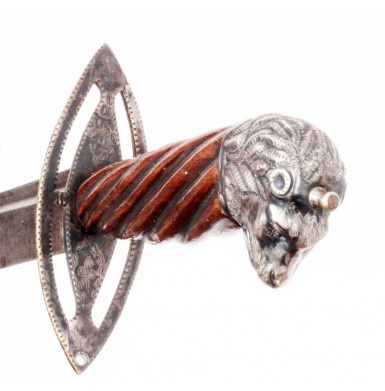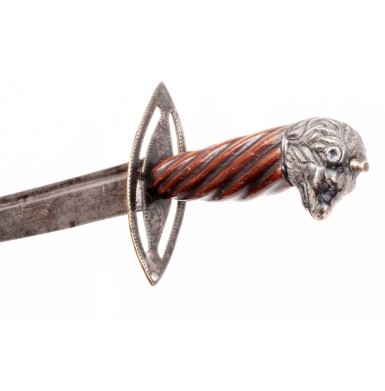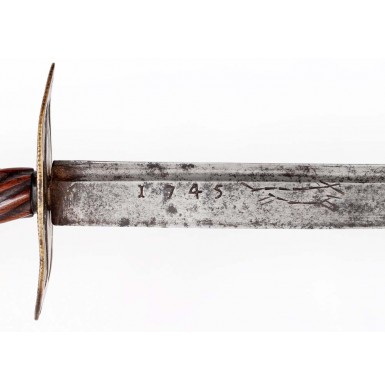American Silver Hilted Hunting Sword - Attributed to William Moulton
- Product Code: EWSK-1380-SOLD
- Availability: Out Of Stock
-
$1.00
This is a wonderful example of an American Made Silver Hilted “Hunting Sword “ or Cuttoe. These American made swords were based upon the English swords of this pattern. The English swords were based upon an evolved European hunting sword pattern that had morphed from a short, straight bladed sword with a rigid hand guard (c1710-1740) to a slightly longer, curved blade sword with a chain hand guard (c1740-1760). The European swords usually had shorter blades than their English contemporaries, and the American made swords tended to have slightly longer blades than the English examples from the same era. The swords were originally intended to dispatch wounded animals at the end of chase (hence the name), and as such were lighter and smaller than swords intended for combat. As the style of sword became more and more popular with Colonial militia officers during the 1750s and 1760s, the American sword became slightly more substantial than its English and European counterparts. Even though they were worn more as a badge of rank by colonial officers than as actual fighting weapons, the swords started to become more robust than the European and English versions, allowing the swords to be used as weapons, if necessary. By the 1770s, the form had become an extremely popular American sword and many high quality cutlers and silversmiths offered well-executed examples, often with lion or eagle head pommels, for sale to militia and eventually Continental officers. Renowned makers like John Bailey in New York, William Moulton in Massachusetts (and later New Hampshire) and Seril Dodge in Rhode Island all produced exquisite examples of this sword from the years leading up to the Revolutionary War, as well as during it. These makers often relied upon imported blades or older, repurposed blades, in addition to locally produced blades, and then hilted them with finely crafted animal head pommels, often in silver.
Like so many of the Revolutionary War period American made swords, this one bears no makers mark that I can find, but has all the hallmarks of a classic American made hunting sword. The masterfully executed lion’s head pommel, with fine detail, is nearly identical to pommels attributed and identified to William Moulton as well those attributed to Seril Dodge and John Bailey. The sword blade is marked with the year 1745 on both sides of the blade, as well as with a (Running Fox) mark. This blade mark had its origins with the Passau blade makers in Bavaria in the 13th century as a “running wolf” and was eventually adopted by the Solingen blade makers in Prussia. Over the centuries the mark came to represent quality in a blade. The mark was eventually adopted by English cutlers. One of the most famous English sword makers to use the mark was Samuel Harvey who worked from the mid-1700s until about 1800. His mark included the “running fox” (the English version of the wolf) with the letters “SH” inside the body of the animal. The mark was copied widely around the world and eventually some American cutlers copied it as well. This sword is marked with what is generally considered an Americanized version of the mark. Instead of the flowing lines of the English version of the fox, the mark is chiseled in straight lines, more akin to German blade marks during the 16th & 17th century. This suggests that that blade was made in Colonial America, and not in England or Solingen. The date of 1745 certainly limits the possible American cutlers who would have hilted and mounted the blade, unless you assume that the blade was re-hilted during its period of use. A comparison to other known examples of American lion pommel, silver hilted swords revealed that very similar (if not identical) lion pommel swords were produced by William Moulton. William Moulton was born July 12, 1720 in Newbury, Massachusetts and is best known as an early American silversmith. Moulton worked in Newburyport, MA from 1742 to 1762. In 1762 he moved to Hempstead, NH where he worked until 1788. In 1788 Moulton relocated to Marietta, OH where he worked until his death in 1793. Only a few Moulton swords are positively identified as being his work, as most appear to have been marked on the scabbard mounts and not on the swords themselves. As only a very few pre-Revolutionary War and Revolutionary War era sword scabbards have survived, it appears that most of Moulton’s swords will forever be attributed to him, rather than positively identified to his shop. One of the features of Moulton’s lion heads was their very narrow faces, and this lion has that narrow face that is attributed to being his work. The style and quality of the silver lion’s head, and the 1745 dated American produced blade, indicates to me, beyond a reasonable doubt, that this sword was at the very least hilted by William Moulton about a decade before the outbreak of the Seven Years War, better know as the French & Indian War. One of the identified Moulton examples has a nearly identical lion head pommel, and almost identical dimensions to the example offered here. That example is dated to c1770 and has a finer grip and more exquisitely executed guard, also in silver. This suggests that Moulton’s style matured as he worked. The styling of this hilt and guard is sometimes referred to a being from “Rhode Island”, but it appears to me that these later production, “Rhode Island” swords (c1770) were merely copies of earlier Moulton produced swords.
The “Cuttoe” here is in about VERY GOOD+ to NEAR FINE condition. It is about 33 ““ in overall length, with a 27 5/8” blade and a 5 7/8” hilt, including the chain stud that projects from the lion’s head. The slightly curved blade is about 1 1/8” wide at the widest point and has a rudimentary 8” false edge running back from the tip. The blade has a wide, unstopped fuller that runs from the ricasso through the beginning of the false edge, about 20” in total length. There is a rudimentary median ridge that runs along much of the fuller, giving it the appearance of having two fullers for a good portion of the length. Both sides of the blade are marked with the date 1745 and have a rudimentary chiseled (Running Fox “maker’s mark”. The date is upside down on the reverse of the blade, and the “4” is fairly weak. The blade has a medium pewter gray patina over its entire surface, with darker areas of age spotting and more significant surface oxidation scattered along its entire length. The blade is mostly smooth, with some scattered patches of light to moderate pinpricking and light surface pitting scattered along the entire length of the blade. The blade shows a couple of minor chips and nicks along the edge, but nothing significant, and there are no signs of abuse or neglect. The ricasso shows moderate surface oxidization and has a dark brown coloration. There is no washer present at the hilt to blade juncture, although one appears to have originally been in place. The hilt has a beautifully executed silver lion’s head pommel, a carved wooden grip and a silver plated brass guard. The lion is truly exquisite and is extremely detailed. The mouth of the lion has a hole to accept a ring for a chain guard, but the ring and chain guard are lost to the ages. The lion’s head is moderately tarnished and does not appear to have been cleaned in a very long time. The spiral grooved wooden grip is in lovely condition with a smoothly burnished appearance much like a well worn wooden banister that has been rubbed smooth by thousands of hands over a hundred years. The grip shows a minor grain crack on the upper right hand edge, near the guard juncture. This appears to be solid and tight, and is probably a drying crack. The grip shows the expected bumps and dings from handling over the years, all of which are worn smooth with age. There are also a couple of flecks of old white paint present on the grip. The grip is reinforced with a small silver ferrule immediately behind the brass hand guard. The guard has a slightly “S’ shaped profile, and is pierced with the typical four slots that are commonly encountered in the guards of swords of this era. The bottom of the guard is also punched with a single hole to accept the missing ring from the chain hand guard. The guard is decorated with simple floral engraving and punched patterns on the grip side, but left plain on the blade side. The inboard side is silver-plated and retains the large majority of this silver plate, which is heavily tarnished. The outboard side of the guard is plain brass, and does not appear to have been plated. The hilt to blade juncture remains fairly tight and secure, with only the most minor wiggle and wobble noted.
Overall this is a really fantastic example of a very high quality early American colonial era sword. This Hunting Sword is very likely the work of noted American silversmith William Moulton and is a truly attractive piece of work. The simplicity of the basic hilting is explained by the fact that this sword was made quite early in his career. However, the quality of the silver lion’s head pommel leaves no doubt that a master silversmith produced it. This would be a fantastic addition to any collection of French & Indian War or Revolutionary War era arms. This sword almost certainly saw use as the side of a Colonial American officer during both wars, initially on the side of the English, and later drawn in wrath against them. Don’t miss your chance to add this fantastic piece of early American history to your collection of fine swords and colonial era weapons.
SOLDTags: American, Silver, Hilted, Hunting, Sword, Attributed, to, William, Moulton



